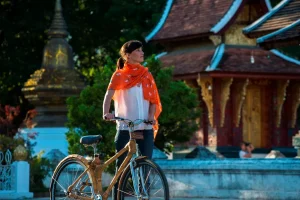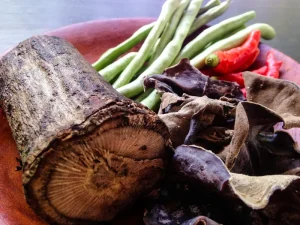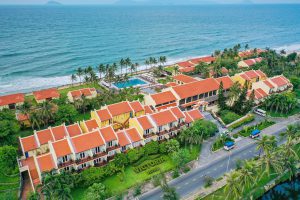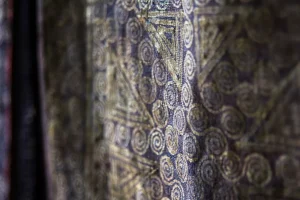Set where the Chau Doc River meets the Hau River (a branch of the Mekong River), a Google Earth image of the town of Chau Doc and its many waterways looks much like a circulatory system, with watery veins and arteries feeding the fertile land
. As it has for centuries, the water provides access to transportation, water for bathing, cooking and drinking, as well as for irrigating the endless swaths of rice fields, leading many to refer to the Delta as “The Rice Bowl” of Vietnam.
The water also provides sustenance and livelihood for countless families who fish to supplement their daily meals.

Near where the two rivers merge, a floating market forms, with barges laden down with produce, samples conveniently strung up on long poles to be seen from afar. Along the banks, houses also float, many doubling as fish farms.

Oanh lives on one of these houseboats along with her husband, brother, two children and parents. Traditionally, these floating houses were buoyed by large bundles of bamboo, but these have since been replaced by PVC piping or metal or plastic barrels.
Oanh’s boat features most of the comforts of home including some potted plants and a small satellite dish that allows them to watch television.
The family pulls an electric line from the road, helped along by bamboo poles every few meters. A pump supplies their water needs which must be boiled before drinking or using to cook.
While only meters from the land, life on the river takes on a certain freedom. “We have cool breezes all day. It’s clean, not dusty like on land,” says Oanh. “We can move our boat wherever we want along the river.”
That freedom comes at a price, though. Vietnam has one of the highest child drowning rates in Southeast Asia and living on the water means parents have to be especially vigilant.
“So many little kids die from drowning. We had to watch our children all the time. When they learned how to swim, about the same time they learned to walk, we could breathe easier.”
There’s also the matter of transport. Oanh and her family have motorbikes which they leave ashore, but to get to town, Oanh will call a local boat “taxi” service. For VND 5,000 (USD 0.25), she can take a trip to the post office or market.
“Also, while my children go to school on land, they don’t get to hang out with friends and go places like other kids because we’re always working.”

The work Oanh and her family does is raise fish. Lots and lots of fish. They’ve installed netting under her houseboat and neighboring workboat creating a space of roughly 1,000 cubic meters where they raise 150,000 fish.
Oanh lifts up a plank from the floor, and tosses in a handful of food pellets, putting the fish into a frenzy. “We have five types of fish. We buy them for VND 2,500 each and after eight to ten months, we can sell them for on average VND 35,000 (USD 1.50) per kilo.
I’ve calculated that they eat about 2.5-3kgs of food each, meaning we need to put out about VND 2.5b (USD 115,000) per season to raise 150,000 fish,” she says shrewdly.

On the workboat, the family makes food for the fish made up of sea fish (because they don’t like the taste of freshwater fish), rice and potatoes. It’s grueling work.

The family started raising fish in 1990 and things were good for about the first five years, which is how they were able to expand the houseboat and build the adjoining work boat.
“But then people on land wanted to get into the business and supply outweighed demand, driving prices down. Nowadays, if we make a profit of VND 500m (USD 23,500) a season, it’s just enough to pay back the bank, pay our workers and our expenses.”

Oanh’s life as well as that of her entire family is closely connected to the fish who swim beneath her home. “Sometimes we hear them thrashing at night.
That means they’re not getting enough oxygen because the river isn’t flowing fast enough. Then we’ll have to get up, angle our motorboat in the right direction and turn on the motor to create a current for them.”

When asked if she sees a long future in fish farming, she responds: “As long as it’s profitable, even just a little, we’ll keep at it. We enjoy doing it. But it’s a hard life and I’d rather not have my children do it. I want them to go to college and get an office job.
On the other hand, because we live right here above the fish, our family is always together. Whatever we lack in money, we make up for love,” she concludes with a smile.
If you go: The floating fish farms are mainly private houses. Visitors must seek permission to board. The Victoria Chau Doc Hotel offers a river tour that includes visiting the floating market as well as a floating fish farm. River excursions can be booked at the tour desk at Victoria Chau Doc or by emailing: [email protected]









